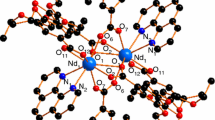Abstract
A series of complexes of transition metalsM(o-phen) 3 X 2, whereM=Fe 2+,Co 2+,Ni 2+,Cu 2+,Zn 2+, andX=Cl −,Br −, has been studied using TG, DTA and spectroscopic methods, to obtain information concerning the decomposition mechanism, the influence of the central metal and halogens on the stability of these complexes and the stereochemical variations caused by heating.
It has been observed from the DTA and TG curves that the complexes decompose, after their dehydration, generally after an endothermic reaction involving the partial substitution of the base in the co-ordination sphere of the metal by the halogen, as can be seen from reflectance spectra. The first base weight loss corresponds generally to one mole of phenanthroline giving the biscomplexes.
In observing the beginning decomposition temperature values one can see that the stability, concerning the central metal as well as the halogen are in the following order:Ni>Fe≅Co≅Cu>Zn, andBr −>Cl−.
Résumé
On a étudié, par TG, ATD et par spectroscopie, une série de complexes des métaux de transition de formule [M(o-phén)3]X 2, où M=Fe2+, Co2+, Ni2+, Cu2+, Zn2+ et X=Cl−, Br−, dans le but de connaître le mécanisme de la décomposition thermique, l'influence du métal M et des halogènes sur la stabilité de ces complexes et les modifications stéréochimiques provoquées par le chauffage.
Par ATD et par TG, on a observé que les complexes, après déshydratation, se décomposent généralement après une réaction endothermique qui met en jeu la substitution partielle de la base dans la sphère de coordination du métal avec l'halogène, comme l'indiquent les spectres de réflexion. La première perte de poids correspond généralement au départ d'une mole de phénanthroline et conduit aux complexes bis.
En comparant les températures initiales de décomposition, il apparaît que la stabilité dépend de la nature du métal central et de l'halogène, suivant l'ordre: Ni>Fe=Co=Cu> <Zn et Br−<Cl−.
Zusammenfassung
Eine Reihe von Übergangsmetallkomplexen mit [Me(o-phen) 3]X2,M=Fe 2+, Co2+, Ni2+, Cu2+, Zn2+ undX=Cl −, Br−, wurden durch TG, DTA und spektroskopische Methoden untersucht um Informationen über den thermischen Zersetzungsmechanismus, den Einschuß des zentralen Metalls, sowie der Halogene auf die Stabilität dieser Komplexe und die erhitzungsbedingten stereochemischen Änderungen zu erhalten.
An Hand der DTA und TG wurde beobachtet, daß die Zersetzung der Komplexe nach ihrer Dehydrierung gewöhnlich nach einer endothermen Reaktion erfolgt, in welcher die teilweise Substituierung der Base in der Koordinationssphäre des Metalls durch das Halogen mit inbegriffen ist, wie dies aus den Reflexionsspektra ersichtlich ist. Der erste Basengewichtsverlust entspricht im allgemeinen einem Mol Phenantrolin, welches die Bis-Komplexe ergibt.
Durch Beobachtung der Anfangstemperaturen der Zersetzungsprozesse ist ersichtlich, daß die Stabilität hinsichtlich des zentralen Metalls in folgender Reihenfolge abnimmt:Ni> Fe≅Co≅Cu>Zn und hinsichtlich des Halogens in folgender Ordnung:Br −>Cl−.
Резюме
Методами ТГ, ДТА и спек троскопии изучен ряд комплексов переходн ых металлов [М (о-фен.)3] Х2, где M=Fе 2+, Со2+, Ni2+, Zn2+ и X=Сl−, Вr−, с целью получения информации о механиз ме термораспада, влия нии центрального металл а и галогенов на стабильность этих ко мплексов и о стереохи мических изменения, вызванных нагреванием. Из данных ДТА и ТГ уста новлено, что комплекс ы распадаются после их дегидратации, обычно после эндотер мической реакции, вкл ючающей частичное замещение основания в координационной сфе ре металла галогеном, как это видно из спектра отра жения. Первая основная потеря веса соответствует одном у молю фенантролина, дающег о бискомплексы.
На основании начальн ой температуры распа да можно сделать вывод, что ста бильность в зависимости от цент рального металла изм еняется в следующем порядке:Ni>Fe СоСи>Zn, а в зависимос ти от галогена в следу ющем:Вr − > Сl−.
Similar content being viewed by others
Bibliography
Burstall, F. H. andNyholm, R. S., J. Chem. Soc. (1952). 3570.
Faye, G. H., Can. J. Chem. 44, (1966). 2165.
Palmer, R. A., andPiper, T. S., Inorg. Chem. 5, (1966). 864.
Jørgensen, C. K., Acta Chem. Scand. 9, (1955). 1362.
Csàszár, J., Acta Chim. Acad. Sci. Hung. 24, (1960). 55.
Coat, A., andRedfern, J. P., Nature 201, (1964). 68.
Newkirk, A. E., Anal. Chem. 32, (1960). 1558.
Kiss, A. andCsászár, J., Acta Chim. Acad. Sci. Hung. 38, (1963). 405.
Madeja, K. andKönig, E., J. Inorg. Nucl. Chem. 25, (1963). 377.
Harris, C. M., andMcKenzie, E. D., J. Inorg. Nucl. Chem. 29, (1967). 1047.
Lee, R. H., Griswold, E., andKleinberg, J., Inorg. Chem. 3, (1964). 1278.
Banks, C. V. andBystoff, R. I., J. Am. Chem. Soc. 81, (1959). 6153.
Author information
Authors and Affiliations
Rights and permissions
About this article
Cite this article
Rossiello, L.A., Cicconetti, L., Giannetta, F. et al. Thermal decomposition of the tris-(o-phen) complexes of some first transition group elements. Journal of Thermal Analysis 7, 81–94 (1975). https://doi.org/10.1007/BF01911628
Received:
Revised:
Issue Date:
DOI: https://doi.org/10.1007/BF01911628




